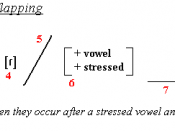The Significance/Function of Phonological Rules in Language
In a language it is often difficult to tell what the phonetic transcription of a sound will be, when not in isolation. That is, the pronunciation of a sound in a word or sentence is influenced by the sounds around it, and thus, may not be the same as our mental phonemic representation. We can determine the proper phonetic transcriptions/representations of these sounds by first applying phonological rules to the phonemic representations.
Every language has a set of phonological rules that are learned sub-consciously by the native speaker. These rules can be applied to individual sounds, but mainly they apply to groups of sounds called natural classes (Fromkin, p.270). The rules help us to understand, what may appear to be irregularities in our language, to actually be predictable forms of speech. A non-native speaker may not be aware of these rules and thus may have difficulty with certain utterances.
By being aware of these rules, a non-native speaker may become more native like in his/her speech.
There are many phonological rules, but I will discuss only three of them here: assimilation rules, feature-addition rules and segment deletion rules.
Assimilation rules are considered feature-changing rules, that is, the value of phonemic features are changed. The assimilation rule states that a sound becomes more similar to a neighboring sound. This is in large part due to the difference in the manner and place of articulation of each sound. When moving from one sound to another we want to move our articulators as little as possible. This easing of the articulators results in the assimilation of the two sounds. Palatalisation is an example of assimilation (Fromkin, p.477).
In palatalisation the alveolar 'sounds /d/ and /t/ are pronounced further back in the mouth' (Avery, p.89). They occur...


